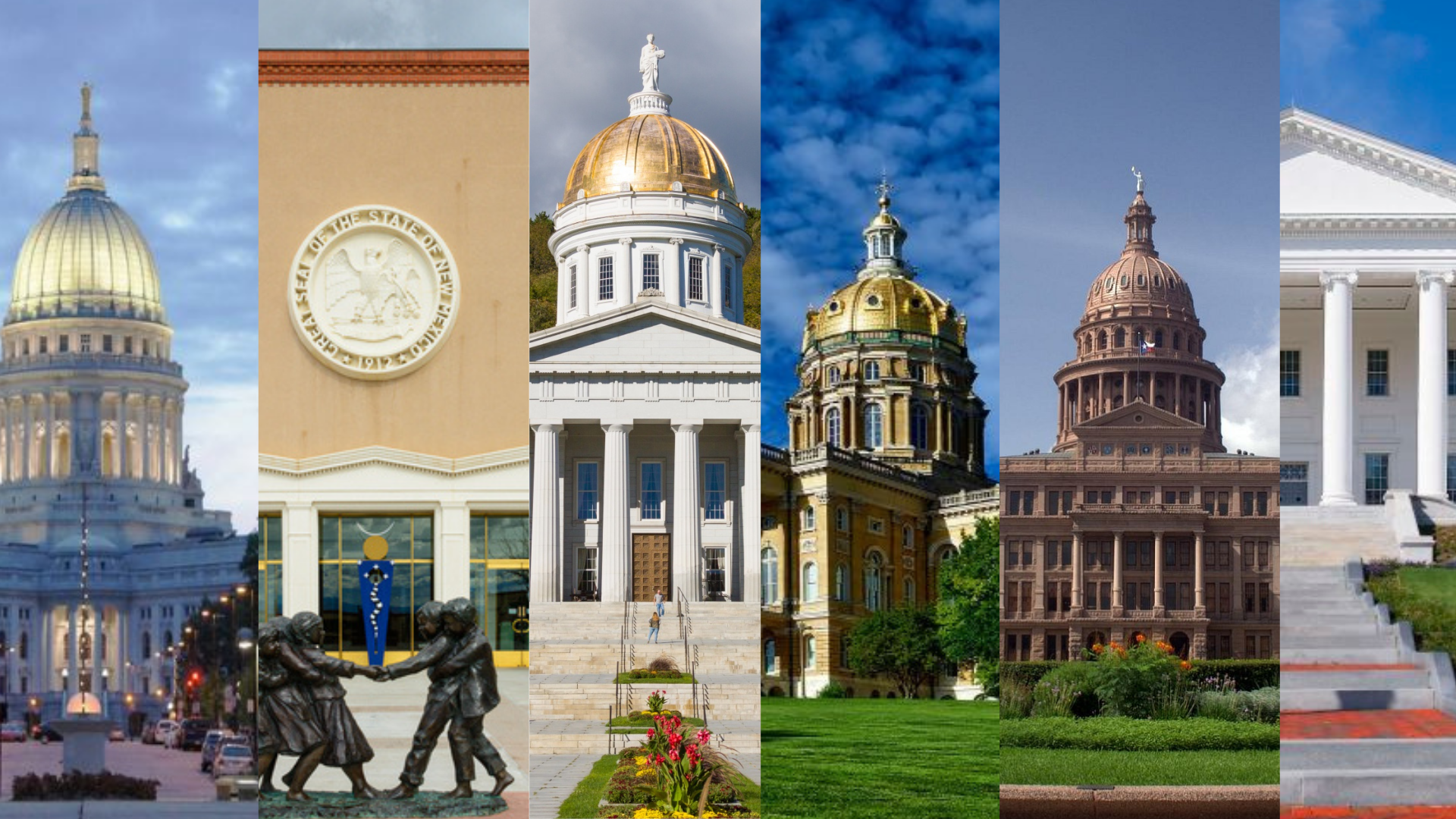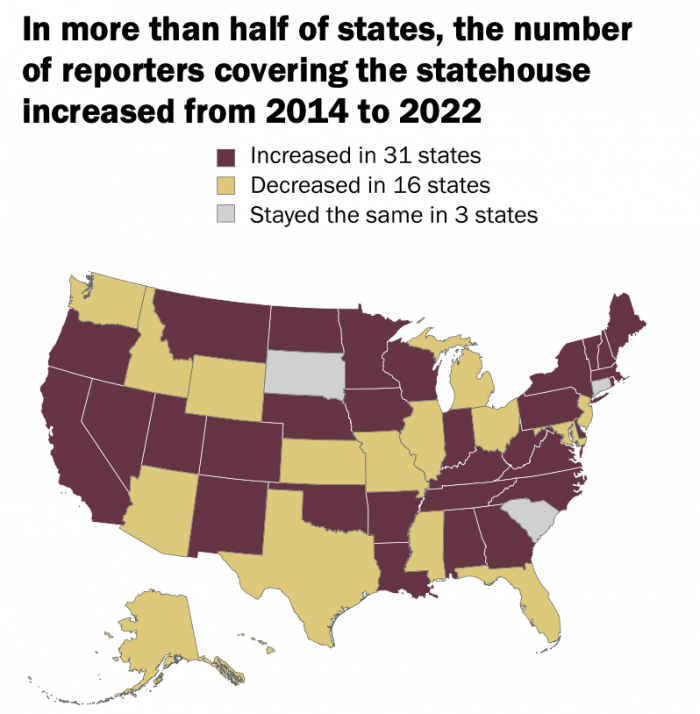
Statehouse reporters, perennially important for accountability journalism and state-level policy coverage, have been particularly needed in the age of Covid-19. From mask mandates and vaccination policies to school and business closings, much of what has shaped everyday pandemic life for Americans has been decided not in Washington, D.C. but places like Olympia, Austin, and Phoenix.
In a followup to their 2014 study on the same topic, the Pew Research Center spent six months gathering data on reporters who cover U.S. statehouses, conducting qualitative interviews with two dozen journalists, and — in a first for the research center — accounting for reporters covering tribal governments.
 The total number of statehouse reporters has increased by 11% since 2014, according to the report released Tuesday. The upward swing was driven by a host of new nonprofit news outlets dedicated to statewide policy and politics, as well as more reporters covering the statehouse part-time. (A part-time statehouse reporter might look like an education journalist who treks to the capitol to cover a bill affecting schools, but doesn’t cover legislative activity or state officials unrelated to her beat.) The number of journalists covering statehouses full-time, however, dropped from 904 reporters eight years ago to 850 journalists in 2022. Full-time reporters now make up less than half of statehouse press corps nationwide.
The total number of statehouse reporters has increased by 11% since 2014, according to the report released Tuesday. The upward swing was driven by a host of new nonprofit news outlets dedicated to statewide policy and politics, as well as more reporters covering the statehouse part-time. (A part-time statehouse reporter might look like an education journalist who treks to the capitol to cover a bill affecting schools, but doesn’t cover legislative activity or state officials unrelated to her beat.) The number of journalists covering statehouses full-time, however, dropped from 904 reporters eight years ago to 850 journalists in 2022. Full-time reporters now make up less than half of statehouse press corps nationwide.
What does that add up to, in terms of overall reporting power in U.S. state capitols? Amy Mitchell, the Pew Research Center’s director of journalism research, and Katerina Eva Matsa, the associate director, said “the answer is kind of a mixed bag.”
“As you point out, the total number of statehouse reporters increased. That increase, however, includes a shift to more part-time statehouse reporting which could impact reporting power,” Mitchell and Matsa wrote in an email. “There are also substantial differences across the states – both in a rise or fall in total reporters as well as changes in full-time numbers.”
Newspaper reporters still account for the biggest portion of those assigned to cover statehouses, but Pew found that their number shrunk from 604 reporters (38% of the reporting pool) in 2014 to 448 reporters (about 25%) in 2022.
As newspaper staffs have been cut, a number of nonprofit newsrooms have stepped in to fill in the gaps. Of the 1,761 journalists who report from state capitols, 20% work for nonprofit news organizations, up from just 6% in 2014. These journalists work for single-state nonprofits like Spotlight PA and CalMatters as well as outlets like States Newsroom, which has reporters in more than 20 state capitols. (Pew Research Center counted openly ideological outlets — even those with nonprofit status — in a separate category.) In 10 states, there are more statehouse journalists working for nonprofits than any other kind of outlet.Commercial digital-first publications — defined to include large outlets like Axios, Politico, and Bloomberg that have launched state-level coverage, as well as local entrants such as Iowa Starting Line and The Colorado Sun — have also doubled their statehouse footprint in the past eight years, according to the report. These for-profit digital newsrooms now make up 5% of those assigned to statehouses, up from 2% in 2014.
Other types of outlets with statehouse reporters include wire services like the Associated Press (6% of the total), radio stations (10%), students or interns (11%), and TV reporters (16%).As you might expect, the size and composition of individual statehouse reporting pools varies widely across the country. States with higher populations and longer legislative sessions tend to have more full-time statehouse reporters.
“Seven states — California, Florida, Michigan, New York, Ohio, Pennsylvania and Texas — are among both the 10 most populous states and the 10 with the largest full-time statehouse press corps,” the report notes. “Similarly, seven states — Alaska, Delaware, North Dakota, Rhode Island, South Dakota, Vermont and Wyoming — are now among both the 10 least populous and the 10 with the smallest full-time statehouse press corps.”
Even among the most populous states, industry changes have played out in different ways. California, for example, has 21 more full-time reporters on the statehouse beat than it did eight years ago, while Texas has 16 fewer full-timers than it had in 2014. Neighboring states New Hampshire and Vermont have similar populations and legislative session lengths, but while Concord has doubled the number of full-time statehouse reporters in eight years (from 5 in 2014 to 10 in 2022), Montpelier lost the majority of its full-time pool (from 15 to just 5 in 2022).
Looking across the nation, the number of reporters covering statehouses increased in 31 states, decreased in 16 states, and remained the same in three.

In its first look at journalists covering the tribal governments, the Pew Research Center found 134 journalists at 44 outlets that cover the governing bodies that make and enforce laws and regulations on reservations and other Indigenous lands.
Interviews and self-reported data indicated a relatively small portion of tribal groupings had governments that were covered by a specific journalist. Just 29 of the more than 150 tribal groupings were represented among the identified reporters, including three — Cherokee, Navajo, and Chippewa — among the five largest in the country.
Several radio stations covering Indigenous issues said that while they don’t have a reporter dedicated to tribal government, they often broadcast the audio of their local tribal council meeting. That kind of arrangement brings us to “a key issue” flagged by reporters covering tribal governments — independence:
The financial support provided by tribes can have significant implications for how outlets operate and how much editorial independence they have. Sterling Cosper, membership manager for NAJA and former manager of Mvskoke Media, which serves the Muscogee (Creek) Nation in Oklahoma, did not offer a very bullish assessment of the state of editorial independence among Indigenous outlets covering tribal governments. Many of them, he said, are effectively precluded from doing investigative journalism and reporting aggressively on sensitive topics.
Cosper said the issue of editorial independence “comes back to the funding. If there was more available funding out there, I would say we operate under a public media model.” Additional sources of revenue, he noted, would help these outlets become “more self-sufficient.”
Reflecting on his time at Mvskoke Media, Cosper said the community began questioning the quality of its journalism when an embezzlement conviction of a tribal leader exposed a large difference between the Tulsa World’s coverage and what Mvskoke Media was able to report.
According to Cosper, this, along with other scandals afterwards, was a factor in the introduction and passing of the tribe’s first free press law. He resigned from Mvskoke Media in 2018 when the tribe repealed a free press law it had previously enacted.
The report also digs into recent changes — such as less in-person interaction between press and legislators, and the use of livestreaming for hearings and legislative sessions — that emerged during the pandemic. Read the full report here.